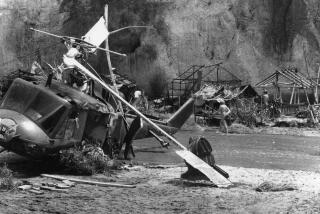Either Everyone Is a Player, or No One in the Air Is Safe
- Share via
Another Cerritos-style air collision could occur at any time. Why? Because the inadequacies in our air-traffic-control system that led to the 1986 tragedy are still with us.
Not that repair attempts aren’t in progress. The Federal Aviation Administration, the Department of Transportation, Congress and the National Transportation Safety Board (which early this month completed its investigation of the collision between an Aeromexico DC-9 and a private single-engine airplane) have been working diligently on finding solutions to the problems that the Cerritos crash demonstrated in such deadly fashion.
Yet the fact that something is being done might lead to the erroneous conclusion that the lessons of Cerritos have been learned, the system repaired and recurrence rendered impossible. In its report, the NTSB urged rapid deployment of a collision-avoidance system and issued three more recommendations: Increase efforts to track down and discipline pilots who violate controlled airspace, upgrade requirements for using altitude-reporting transponders by all aircraft in certain high-density areas, and include smaller planes in the air-traffic-control system’s anti-collision computer programs.
This is just the beginning, however. With airline delays growing daily and the overburdening of the system sparking recent warnings to the FAA from NTSB Chairman Jim Burnett, the inability of the air-traffic-control structure to handle the demand for airspace since the deregulation of commercial aviation has become painfully apparent. That shortcoming, coupled with the FAA’s generic inability to adequately separate all air traffic, simply means that the changes needed in the air-traffic-control system are of a magnitude that only Congress can handle.
Whether the best solution would involve a spinoff of air-traffic control into a government corporation (as the Air Transport Assn. has urged) or some less radical alteration of the FAA’s structure is certainly a debatable question, but one thing is clear: Major and substantive overhaul is needed nationwide in the structure and the philosophy and the funding of the air-traffic-control system--not just quick fixes and additional personnel.
To understand why traffic-separation problems are so hard to solve, we have to realize that the safety of the system depends on three central and essentially dangerous assumptions:
--Neither the human controller nor his electronic equipment will ever make a mistake.
--With his radar scope the controller will always be able to “see” (if not control) all relevant airborne traffic in time to prevent a collision.
--Even if the first two assumptions are mistaken, pilots will always be able to see each other in time to avoid a collision.
Not one of the assumptions is true. Predictably, in the case of Cerritos, all three assurances failed. The overall reason for that accident (and the reason for most reported and unreported near-hits nationwide) is that the system is vulnerable to “wild card” airplanes and cannot always detect them, control them or guide others around them. The system as we currently use it does not defend against the one pilot in millions who makes a mistake, blunders into controlled airspace at the worst possible time on a collision course with another plane, and either does not show up on the controller’s screen, is not noticed by the overburdened controller when he does appear or is noticed but assumed to be at a non-conflicting altitude (because the intruding plane does not have or is not using an altitude-transmitting transponder).
And it can never rely on the bankrupt concept of “see and avoid” in a sky full of high-speed jet transports flown by crews whose workload and windscreens give them inadequate visibility for the task.
As NTSB member John Lauber said, “The (control) system has to assume that there are going to be blunders.”
But do the “fixes” already announced by the FAA (and those just recommended by the NTSB) incorporate this assumption or solve this problem? In a word: no. Nor can they, without systemic and conceptual overhaul of the way we control the growing air traffic in our skies.
Here we are approaching the 1990s with an air-traffic-control structure rooted in the non-radar system of the ‘50s in which only the “players”--aircraft under positive control--were kept apart. That was a fiction even then, since “non-players” were constantly popping up to threaten the controlled aircraft. In today’s dense, high-speed environment it is even more dangerous. Either everyone in high-density airspace becomes a player or no one is really safe.
How do we bring everyone into the game as a player? The NTSB recommendations are a good start, as are the re-drawing of the terminal-control areas that the FAA has initiated. But much more must be done, and quickly.
Basically, we have been applying Band-Aids and field dressings to a major wound in order to stabilize the patient. That was the proper first response. Now it’s time for major surgery.
More to Read
Inside the business of entertainment
The Wide Shot brings you news, analysis and insights on everything from streaming wars to production — and what it all means for the future.
You may occasionally receive promotional content from the Los Angeles Times.










